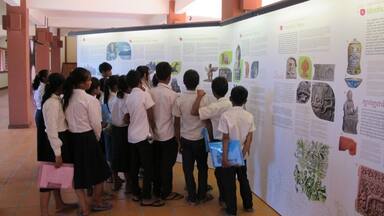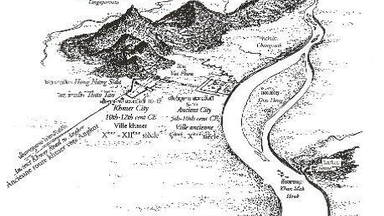Vat Phou and Associated Ancient Settlements within the Champasak Cultural Landscape
Vat Phou and Associated Ancient Settlements within the Champasak Cultural Landscape
The Champasak cultural landscape, including the Vat Phou Temple complex, is a remarkably well-preserved planned landscape more than 1,000 years old. It was shaped to express the Hindu vision of the relationship between nature and humanity, using an axis from mountain top to river bank to lay out a geometric pattern of temples, shrines and waterworks extending over some 10 km. Two planned cities on the banks of the Mekong River are also part of the site, as well as Phou Kao mountain. The whole represents a development ranging from the 5th to 15th centuries, mainly associated with the Khmer Empire.
Description is available under license CC-BY-SA IGO 3.0
Vat Phou et les anciens établissements associés du paysage culturel de Champassak
Le paysage culturel de Champassak, y compris l'ensemble du temple de Vat Phou, représente une zone de paysage planifiée remontant à plus de mille ans et remarquablement bien conservée. Afin d'exprimer la conception hindoue des rapports entre la nature et l'homme, il a été façonné selon un axe compris entre le sommet de la montagne et les rives du fleuve dans un entrelacs géométrique de temples, de sanctuaires et d'ouvrages hydrauliques s'étendant sur quelque 10 km. Le site comprend aussi deux villes anciennes, construites sur les rives du Mékong et la montagne de Phou Kao, l'ensemble représentant un processus d'aménagement s'étendant sur plus de mille ans, du Ve au XVe siècle, associé surtout à l'Empire khmer.
Description is available under license CC-BY-SA IGO 3.0
معبد فات فو والمنشآت القديمة الملحقة بالمنظر الثقافي في مقاطعة تشامباساك
يشكل المنظر الثقافي في مقاطعة تشامباساك بما في ذلك معبد فات فو بأكمله منطقة مخططة أنشئت منذ أكثر من ألف عام وجرى حفظها بصورة ممتازة. وقد تم تصميم هذا المنظر حسب محور ممتد بين قمة الجبل وضفاف النهر ضمن مشبكات هندسية من المعابد والأضرحة والمنجزات المائية الممتدة على 10 كيلومترات تعبيراً عن المفهوم الهندوسي للعلاقات بين الطبيعة والإنسان. ويتضمن الموقع ايضاً مدينتين قديمتين شيّدتا على ضفاف نهر ميكونغ وجبل فو كاو في منظر يجسّد عملية تنظيم استغرقت أكثر من ألف سنة أي من القرن الخامس حتى القرن الخامس عشر وارتبطت بامبراطورية الخمير بصورة خاصة.
source: UNESCO/CPE
Description is available under license CC-BY-SA IGO 3.0
占巴塞文化景观内的瓦普庙和相关古民居
占巴塞文化景观,包括瓦普神庙建筑群,是一处完好保留了1000多年的人类文化景观。占巴塞文化景观,以山顶至河岸为轴心,在方圆10公里的地方,整齐而有规划地建造了一系列庙宇、神殿和水利设施,完美表达了古代印度文明中天人关系的文化理念。占巴塞文化景观还包括湄公河两岸的两座文化名城和普高山,体现了公元5世纪到15世纪以高棉帝国为代表的老挝文化发展概况。
source: UNESCO/CPE
Description is available under license CC-BY-SA IGO 3.0
Культурный ландшафт Тямпасак с храмовым комплексом Ват-Фу и окружающими древними поселениями
Этот объект Всемирного наследия представляет собой спланированный более тысячи лет назад и прекрасно сохранившийся до наших дней ландшафт, включающий храмовый комплекс Ват-Фу. Его планировка подчеркивает неразрывную связь человека с природой. Все строения, растянувшиеся на 10 километров, выстроены по линиям, спускающимся с горных вершин к берегам реки Меконг. Их разбивают геометрические формы храмов, святилищ, гидравлических механизмов. Объект включает два древних города, построенных на берегу Меконга и в горах Фу Као. Весь этот культурный ландшафт создавался на протяжении более тысячи лет - с V по XV век в эпоху Кхмерской империи.
source: UNESCO/CPE
Description is available under license CC-BY-SA IGO 3.0
Vat Phu y antiguos poblamientos anejos del paisaje cultural de Champasak
Creado por el hombre, el paisaje cultural de Champasak comprende el templo Vat Phu y se halla en un estado admirable de conservación, pese a que tiene más de mil quinientos años de antigüedad. Ideado para expresar la visión hindú de las relaciones entre el hombre y la naturaleza, se creó en función de un eje trazado desde la cumbre de una montaña hasta las orillas de un río, a fin de dar una configuración geométrica a todo un conjunto de templos, santuarios y obras hidráulicas que se extienden a lo largo de unos diez kilómetros. El sitio, que comprende también el monte Phu Kao y dos antiguas ciudades construidas en las márgenes del río Mekong, es ilustrativo de un proceso de creación de un paisaje cultural a lo largo de más de mil años –desde el siglo V hasta el XV– que se debe principalmente al Imperio Jémer.
source: UNESCO/CPE
Description is available under license CC-BY-SA IGO 3.0
チャンパサック県の文化的景観にあるワット・プーと関連古代遺産群
source: NFUAJ
Cultuurlandschap Champasak - Vat Phou en bijbehorende oude nederzettingen
Source: unesco.nl
Justification for Inscription
Criterion iii The Temple Complex of Vat Phou bears exceptional testimony to the cultures of south-east Asia, and in particular to the Khmer Empire which dominated the region in the 10th–14th centuries. Criterion iv The Vat Phou complex is an outstanding example of the integration of symbolic landscape of great spiritual significance to its natural surroundings. Criterion vi Contrived to express the Hindu version of the relationship between nature and humanity, Vat Phou exhibits a remarkable complex of monuments and other structures over an extensive area between river and mountain, some of outstanding architecture, many containing great works of art, and all expressing intense religious conviction and commitment.




